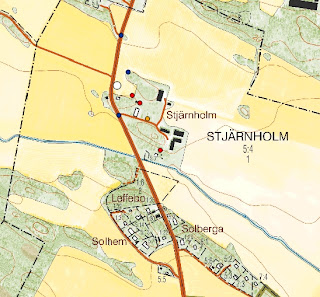Today we
are going to investigate the village
of Stjärnholm
The first thing usually described on each
homestead is the name of the farmer. These names are very common even today,
and almost all of them have surnames ending with “-son”. In this particular
village we have two farmers (in homestead 1 and 3) surnamed “Larsson”. We
cannot be sure that these two are related to each other as this is a common
surname, but as they inhabit the same village it is quite likely.
After the names comes the land owning nature
of the homestead, such as “krono”, “skattekrono”, “frälse” etc. If the land is
“frälse” (owned by a noble) sometimes the name of the nobleman/woman or the
estate is noted.
The third thing described is the value of
the farmers’ land in the unit “öresland”. Öresland is a unit that does not
necessarily describe the amount of
land; it can also be a description of the revenues. The exact meaning of this
unit seems somewhat uncertain depending on what area you are investigating. In
Uppland, there seems to be a quite clear correlation between öresland and tunnland. In the YGK-project we are converting all land values into
the same unit, called penningland (1 öresland is the same as 24 penningland) which is more common in
this period. This is done in order to make the statistics from various areas
comparable with each other.
After this, the annual revenues of the
homestead are described. Each homestead usually use the two field system and
therefore the revenues are described for each year of farming.
Under the revenues, you can sometimes find
information on areas used by the farmer which lie outside the village (in Swedish
“utjordar”), often in a neighbouring area. Sometimes the revenues for these
patches of land can be found in the homesteads description, but most of times this
is described in another map, if such exists. More on this below.
Another thing to note here is something
found above the description of the homesteads. We can usually find information
here about the outfields (though it is not really fields) of the village. The
outfields or the “outlands” (perhaps
a better term) of a village are usually used for grazing, gathering of
firewood, fishing and some hunting. Outlands are usually not described in
detail, but the quality is defined by terms such as “good fishing” or “almost
no firewood at all”. In this case we can read that the outland of Stjärnholm
consists of bare ground which provides poor grazing.
Now we will
investigate the homesteads:
This farm
also owns three patches of land in other areas. Specifically these areas are:
“Wreeta”, “Fänsgiärde” and “Fittja parish”. If these areas are mapped or not we
cannot at the moment know. All that can be said is that they do not exist in
the same volume of maps (named A16).
In short:
Homestead Owning Fields(tunnland) Meadows(lass) Value(pen)
1 skattekrono 21.945 15.448 336
2 frälse 23.121 16.275 354
3 frälse 23.121 16.275 354
That was
all for now. Hope you have enjoyed your visit to Stjärnholm village!
NOTE:
All maps taken from http://www.lantmateriet.se/
NOTE:
All maps taken from http://www.lantmateriet.se/











